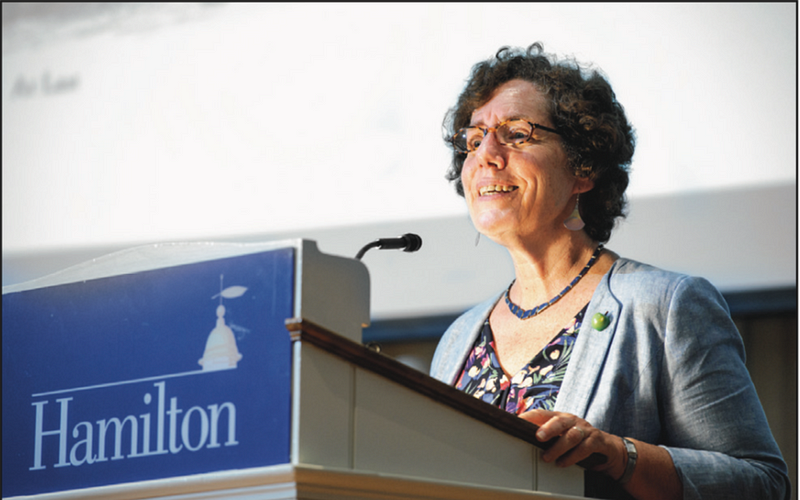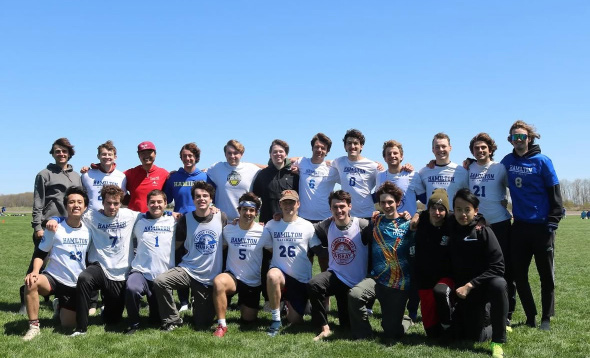
On Monday, Sept. 17, in honor of Constitution Day, award-winning journalist Elaine Weiss K’72 gave a lecture in the College Chapel on her book
The Woman’s Hour: The Great Fight to Win the Vote
, which was recently optioned by filmmaker Steven Spielberg for a major television production, with Hillary Clinton as an executive producer. It is the story of how the 19th Amendment came to be — in other words, the fight for the vote for women.
“Women were not forgotten but purposely left out,” said Weiss. “Given no voice […] denied the most fundamental right of a democracy — the vote.”
The Woman’s Hour
is a story detailing the past limitations of the Constitution, but also a recognition of the Constitution as a living document with the ability to be changed, improved, and amended.
Weiss’ book recounts the struggle to make such a change in the Constitution possible, saying the 19th Amendment corrected what the Founding Fathers willingly left out. “The 19th Amendment wasn’t just a legal change, not just a constitutional change,” said Weiss. “It didn’t just double the national electorate, it didn’t just make women full citizens — it marked a societal change and a cultural shift.”
This shift did not come easily — it required more than 72 years of fighting and marshalling of collective strength to be achieved. From the Seneca Falls Convention to six-weeks of activism and advocacy in Tennessee — the last state needed to ratify the 19th Amendment — this movement was made possible by the work of women who persisted despite obstacles and backlash from their fellow citizens.
Weiss mentions that an essential part of the movement was women actively challenging faulty perceptions of their intelligence, strength, purpose, and determination. Furthermore, suffragists like Susan B. Anthony and Virginia Minor used civil disobedience and defiance to advance the goals of the movement, regardless of the consequences. Weiss described how three generations of suffragists faced opposition from politicians, clergymen, corporations, and other women, who imposed obstacles on the activists, including social ridicule, physical violence, and imprisonment. Weiss also spoke to the other methods employed by the suffragists such as building advocacy campaigns and lobbying. She emphasized that protesting and marching was only effective due to the suffragists following through on their demands for political action.
Weiss praised the suffragists but did not shy away from speaking about the racial issues that arose between the abolition and suffrage movements — two groups that had initially supported each other. Their respective leaders, however, were told that the nation could not handle two reforms of such magnitude, causing what Weiss calls a “heartbreaking split.” Feeling that the abolitionists had deserted them and were setting the suffragists back, many suffragists turned against the abolitionists. Elizabeth Stanton and Susan B. Anthony refused to support the 14th and 15th Amendments because women were not included, and in anger expressed violent and racist sentiments against black and immigrant men.
Weiss’s passionate lecture covered political power, political will, and an account of how change is made in a democracy. Elizabeth Vasquez ’19, who had the chance to meet and talk with Weiss said, “Weiss is extremely passionate, she is very excited that this story is reaching so many people. She seems hopeful that it can make a great impact in our future.”
Weiss is hoping that her book can both offer a historical account of a pivotal amendment to the Constitution and also demonstrate how change is possible through the mobilization of determined citizens willing to fight and exercise their political power. She concluded with a word of reminder and encouragement to the women in the audience, saying, “Hamilton women, when you vote in the November elections, it will be proof the suffragists won.”

















